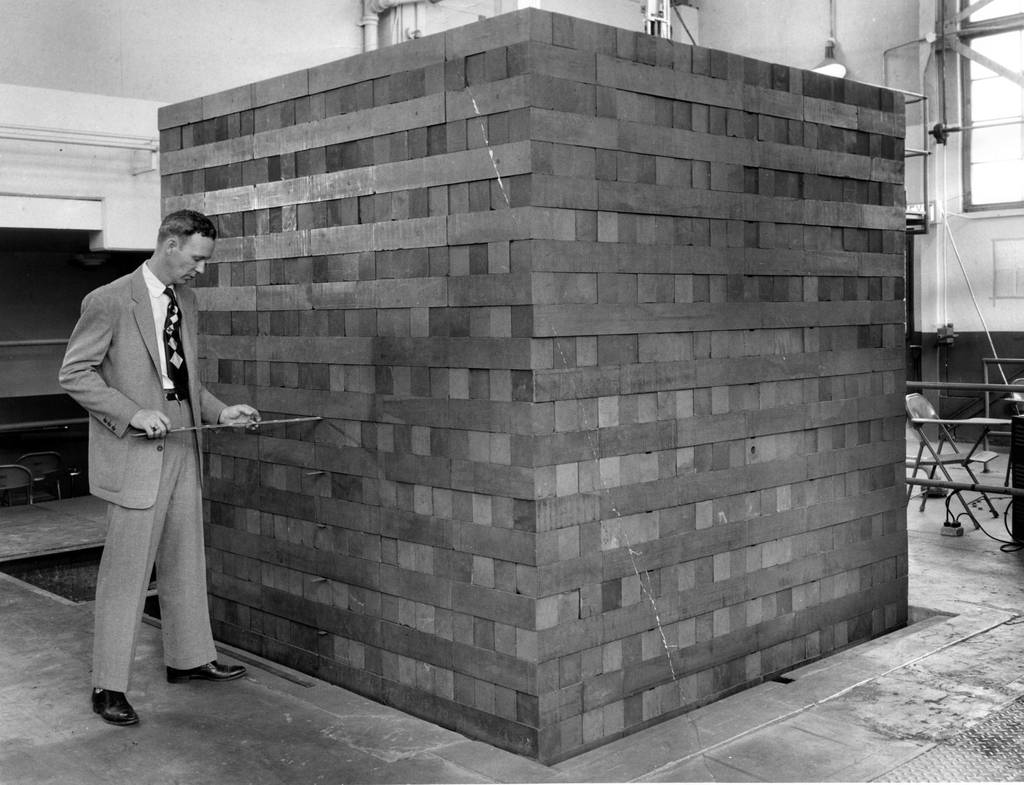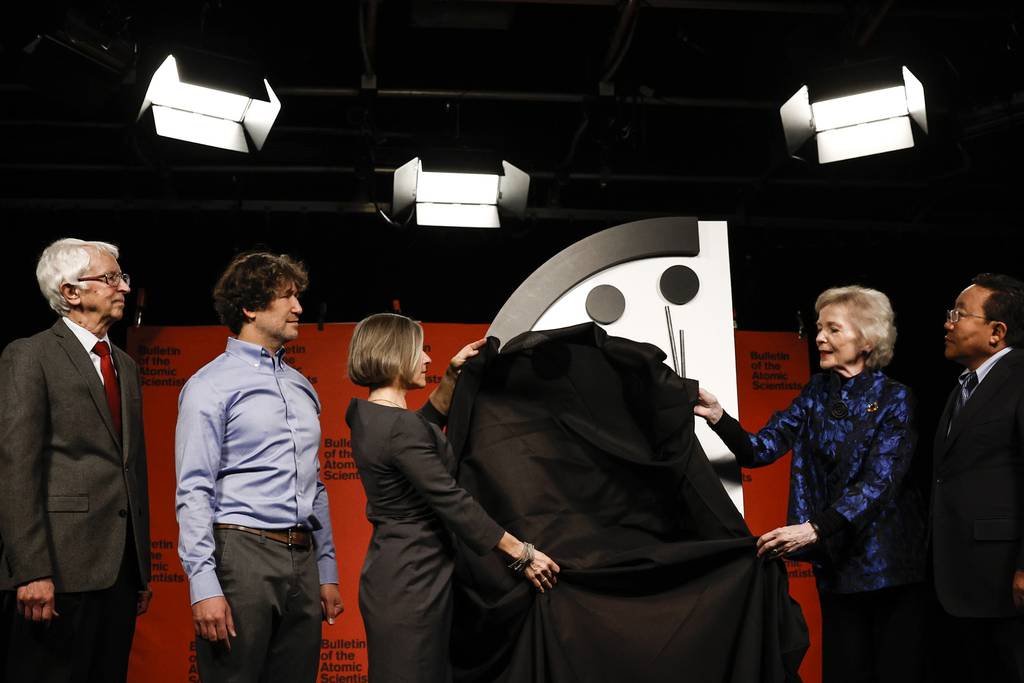The Oct. 1, 1945 letter is just three paragraphs typed on onion skin paper, under a curiously sparse letterhead containing only a four-digit P.O. Box located somewhere in Santa Fe.
But its subject matter — along with the man whose signature is scrawled at the end — would permanently alter the history of the world in ways that proved both groundbreaking and horrifying.
“This letter is to acknowledge your contribution to the development of the atomic bomb,” the document reads. “The striking success of this project was only made possible by the work and sacrifices of the military members. … You and your colleagues have consistently turned out high quality work, and throughout the long period of high pressure effort you have cheerfully cooperated in meeting the most urgent demands of this project.”
Signed: Very truly yours, J. Robert Oppenheimer, director.
Roughly seven decades ago, this message was sent in an envelope stamped “ESSENTIAL” to Chicago-area native Carlo Conterato, a machinist who worked on the Manhattan Project in Los Alamos, New Mexico. For 14 months, Conterato served the military’s top-secret program as part of the Special Engineer Detachment. In the project machine shops, he labored as a toolmaker constructing the jigs, fixtures, dies and miscellaneous parts that were crucial to the birth of the atomic bomb that would ultimately end World War II.
His son, Dean Conterato, a radiation oncologist in the north suburbs, came across the letter in a folder of family memorabilia about a decade ago, years after his father’s death at age 66 in 1986. Finding a letter from the theoretical physicist known as the “father of the atomic bomb,” was a bit astonishing, he said.
As the recently released historical drama “Oppenheimer” exceeds $400 million at the global box office, roots of the biographical film’s namesake — and the Manhattan Project he led — run deep in the Chicago area.
Among the most important Manhattan Project sites was the Metallurgical Laboratory at the University of Chicago, which drew brilliant scientific minds from across the nation. In 1942, in a squash court under the stands at Stagg Field at the university, Nobel Prize winning physicist Enrico Fermi achieved the first self-sustaining nuclear chain reaction — a scientific advancement that paved the way for the atomic bomb.
Then, as the United States drew up plans to use the weapon for the first time, notable scientists at the Metallurgical Laboratory issued a grave call for restraint, a famed document known as the Franck Report. After the devastating bombings of Hiroshima and Nagasaki, Manhattan Project scientists founded the Bulletin of the Atomic Scientists at the University of Chicago, urging arms control and raising awareness of threats to humankind. Oppenheimer served as the first chair of the Bulletin’s board of sponsors.
Today, the Bulletin continues to warn of manmade threats to humanity: Its iconic Doomsday Clock, a metaphorical timepiece, represents how close humanity is to global catastrophe based on the state of international affairs, with midnight representing the end of the world.
The physical clock, which is kept at the University of Chicago, now lingers at a perilous 90 seconds to midnight — the closest it has ever been to striking 12 since its inception in 1947.
As for the Conterato family, the son doesn’t know much about his father’s time behind the 10-foot tall barbed wire fence that encircled the highly classified work of the Los Alamos National Laboratory and adjacent community.
During World War II, Carlo Conterato was drafted into the Army, his son recounted. The soldier’s bags were packed and he thought he was headed to fight in Europe. Then military police, upon learning that he was a skilled machinist, pulled him from a line and told him “get on that train,” bound for the New Mexico desert instead, the son recounted.
:quality(70)/cloudfront-us-east-1.images.arcpublishing.com/tronc/VOQVEEBJ6NDFZERJN2ZZT7J5MQ.jpg)
The legacy of the Manhattan Project was complicated for Carlo Conterato, as it was for the world.
The last-minute switch might have saved his life from the European theater of the war.
“I wish I would have been able to talk with him more about it,” Dean Conterato said.
Yet the father and son never got a chance to discuss those wartime memories: Carlo Conterato suffered from dementia in his 50s, when Dean Conterato was just a teenager. The son has always wondered if the early onset of the disease was spurred by his father’s likely exposure to potentially hazardous heavy metals such as uranium and plutonium during his days at Los Alamos.
Dean Conterato was recently biking past Red Gates Woods in the Palos Forest Preserve.
There, a large granite slab marks what’s known as Site A, a former Manhattan Project research complex where “the world’s first nuclear reactor was rebuilt in 1943 after its initial operation at the University of Chicago,” according to the inscription on the marker.
Site A, which closed in 1954, remains the burial site of the first nuclear reactor. Years of environmental cleanup ensued, until the area reopened for public use in 1991, according to the Forest Preserves of Cook County.
Dean Conterato said the scene evoked memories of his father, who was offered an opportunity to stay on at Los Alamos and help with bomb testing after the war’s end, which he declined in favor of rejoining his wife and starting a family.
“But that was part of one of the historic events of modern history, the dawning of the Atomic Age,” his son said. “There’s a little bit of pride that he was involved in it.”
It was early 1942, less than a year after the Japanese attack on Pearl Harbor, and the race was on to develop an atomic bomb before the Nazis could do so in Germany.
Five thousand scientists at the University of Chicago were laboring at a frenetic pace “day in and day out” to “wrest the secret of atomic energy from the universe,” a Chicago Daily Tribune article revealed several years later. The top-secret mission: Determine whether creating and controlling a nuclear reaction was even possible, a necessary precursor to the development of an atomic bomb.
“One way to look at the development of the nuclear bomb was that it was a relay race, and the Metallurgical Lab was the first leg in the relay,” said John Mark Hansen, a professor in the political science department at the University of Chicago and author of the book “The City in a Garden: A Guide to the History of Hyde Park and Kenwood.” “They feared what the consequences would be if Hitler ended up having a nuclear weapon and the United States didn’t. That would have been a catastrophe.”

The world’s first nuclear reactor, dubbed “Chicago Pile-1,” was a “20-foot-tall pile of graphite blocks studded with hundreds of smaller blocks of uranium” assembled under the west stands at Stagg Field on campus.
One University of Chicago student recalled living at the time in Foster Hall dormitory at 59th Street and University Avenue, a few blocks from the atomic pile.
“I was totally unaware of this historic event and how close we were to danger,” she said in a Tribune letter to the editor decades later. “As I have often recounted, there were no security guards to interfere with our wanderings under the stands. That thought continues to amaze me.”
There on that field, at 3:53 p.m. on Dec. 2, 1942, Fermi and his fellow scientists recorded the first self-sustaining chain reaction in history.
Those present celebrated their success with a bottle of Chianti, sipped out of paper cups.
Lab assistant Ted Petry was the last living witness of the first self-sustaining nuclear reaction, until his 2018 death at 94.
“When they opened that Chianti bottle, everybody shared,” Petry told the Tribune in 2017. “Not just the big wheels but everybody who was there. So I got a little sip of the wine.”

He had worked in the makeshift lab under the stands of Stagg Field, and his job included picking up radioactive material and constructing the graphite blocks that comprised Chicago Pile-1.
“I used to go downtown and pick up the radioactive materials in little canisters, stick it in my pocket and bring it back,” Petry said.
Regular blood tests at the university hospital revealed that his red blood count was falling, he recalled.
“And they decided that, ‘Well, we’d better pick it up with a station wagon with a big lead container where you could put the radioactive material in it,’ ” he had said.
Yet Petry had been certain the dangerous work “didn’t affect me.”
“I’ve got four good, healthy children,” he had said.
That scientific discovery would lead to major advancements in chemistry, biology and medicine. In 1951, a reactor built by Argonne National Laboratory — which was born from the Manhattan Project — created the first usable nuclear-generated energy. Nuclear power now accounts for roughly 20% of electricity generated nationwide, according to the Department of Energy.
Yet many of the Manhattan project’s scientists grew deeply troubled by the more destructive fruits of their achievement: The development of the first atomic bombs.
On June 11, 1945, a cohort of these scientists issued the Franck Report, which argued against American leaders using nuclear weapons in an unannounced attack on Japan, urging instead a demonstration of the bomb to illustrate its terrifying power.
“If the United States would be the first to release this new means of indiscriminate destruction upon mankind, she would sacrifice public support throughout the world, precipitate the race of armaments, and prejudice the possibility of reaching an international agreement on the future control of such weapons,” cautioned the report, which was named for its chairman John Franck, Nobel Prize winning University of Chicago physicist.
Despite the scientists’ warnings, on Aug. 6, 1945, the United States dropped an atomic bomb nicknamed “Little Boy” on Hiroshima. Three days later, another one called “Fat Man” exploded in Nagasaki. Japan surrendered shortly after, ending the war.
The combined death toll was estimated at more than 100,000.
“(Those scientists) understood that use would be the first time this was used in warfare, and it could potentially set a precedent for the future,” said Rachel Bronson, president and CEO of the Bulletin of the Atomic Scientists at the University of Chicago.
The Bulletin — established in Chicago in 1945 by Manhattan Project scientists — has evolved into a group of world-renown scientists who continue to inform the public about manmade threats to humanity’s survival. While the Bulletin’s early focus was nuclear weapons and the global arms race, its mission has since expanded to warn of the perils of climate change as well as monitor new — and potentially disruptive — technologies.
In January, the Bulletin moved the fateful minute hand of its Doomsday Clock 10 seconds closer to the world’s end. The clock is now set to 90 seconds to midnight — representing “a time of unprecedented danger” — due to the Russian invasion of Ukraine, worsening climate change and other threats, according to the Bulletin.

Bronson believes the movie “Oppenheimer” resonates with audiences today because the world faces similar concerns when it comes to managing the risks emanating from scientific breakthroughs. Just as Oppenheimer and other atomic scientists of his age advocated for arms control, Bronson draws parallels to experts who have recently sounded the alarm on the threats posed by advancements in artificial intelligence.
“They are really having their Oppenheimer moment,” she said. “They are seeing artificial intelligence as an existential threat. They are telling us we should be worried about it. They are asking to be regulated or governed. And we should take that very seriously.”
For example, President Joe Biden in late July announced that several major tech firms voluntarily agreed to meet AI safeguards put forth by the White House.
“We must be clear-eyed and vigilant about the threats emerging — of emerging technologies that can pose — don’t have to, but can pose — to our democracy and our values,” he said.
Biden added that there’s more work to do in terms of new laws, regulations and oversight.
“All advancement has risks and benefits … it’s very rarely one or the other,” Bronson said. “Our ability to manage the risks, to reduce the risks, will allow us to harness more of the benefits. That’s the story of the Manhattan Project. And I think it’s what we’re grappling with today.”
eleventis@chicagotribune.com






